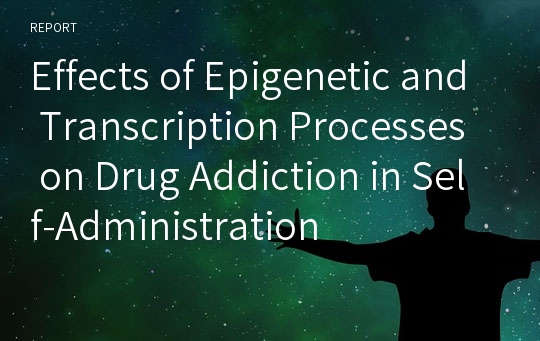Effects of Epigenetic and Transcription Processes on Drug Addiction in Self-Administration
qkanak
다운로드
장바구니
목차
1. Abstract2. Models
3. Method
4. Results
5. Discussion
6. Conclusion
본문내용
AbstractAcute and chronic drug exposure are known to cause changes in gene expression in different regions of the brain. These changes in transcription activity is hypothesized to be brought about by a complex interaction of post-translational modifications of the chromatin and DNA, collectively referred to as epigenetic regulation. Understanding the epigenetic and transcriptional mechanisms of addiction is essential in furthering our knowledge of the genetic etiology of addiction-related behaviors. The self-administration animal model, which exhibits high validity for measuring human addiction behavior, has served a crucial role in shedding light on such processes. This literature review is a summary of the major findings of self-administration studies with regards to epigenetic processes of addiction to the following drugs: 1) cocaine; 2) heroin; and 3) methamphetamine.
Effects of Epigenetic and Transcription Processes on Drug Addiction in Self-Administration Models
참고 자료
Cadet, J. L., Brannock, C., Jayanthi, S., & Krasnova, I. N. (2014). Transcriptional andepigenetic substrates of methamphetamine addiction and withdrawal: Evidence from a long-access self-administration model in the rat. Molecular Neurobiology, 51(2), 696-717. doi:10.1007/s12035-014-8776-8
Center for Behavioral Health Statistics and Quality. (2016). 2015 National survey on drug
use and health: Detailed tables. Rockville, MD: Substance Abuse and Mental Health Services Administration.
Deschatrettes, E., Romieu, P., & Zwiller, J. (2013). Cocaine self-administration by rats is
inhibited by cyclic GMP-elevating agents: involvement of epigenetic markers. The International Journal of Neuropsychopharmacology, 16(7), 1587-1597. doi:10.1017/s1461145712001630
Hopfer, C. J., Crowley, T. J., & Hewitt, J. K. (2003). Review of twin and adoption studies of
adolescent substance use. Journal of the American Academy of Child & Adolescent Psychiatry, 42(6), 710-719. doi:10.1097/01.chi.0000046848.56865.54
Jaenisch, R., & Bird, A. (2003). Epigenetic regulation of gene expression: how the genome
integrates intrinsic and environmental signals. Nature Genetics, 33(3s), 245-254. doi:10.1038/ng1089
Keverne, E. B., & Curley, J. P. (2008). Epigenetics, brain evolution and behaviour. Frontiers
in Neuroendocrinology, 29(3), 398-412. doi:10.1016/j.yfrne.2008.03.001
Krasnova, I. N., Chiflikyan, M., Justinova, Z., Mccoy, M. T., Ladenheim, B., Jayanthi, S., . . .
Cadet, J. L. (2013). CREB phosphorylation regulates striatal transcriptional responses in the self-administration model of methamphetamine addiction in the rat. Neurobiology of Disease, 58, 132-143. doi:10.1016/j.nbd.2013.05.009
Kreek, M. J., Nielsen, D. A., Butelman, E. R., & Laforge, K. S. (2005). Genetic influences on
impulsivity, risk taking, stress responsivity and vulnerability to drug abuse and addiction. Nature Neuroscience, 8(11), 1450-1457. doi:10.1038/nn1583
Kumar, A., Choi, K., Renthal, W., Tsankova, N. M., Theobald, D. E., Truong, H., . . . Nestler,
E. J. (2005). Chromatin remodeling is a key mechanism underlying cocaine-induced plasticity in striatum. Neuron, 48(2), 303-314. doi:10.1016/j.neuron.2005.09.023
Lewis, C. R., Bastle, R. M., Manning, T. B., Himes, S. M., Fennig, P., Conrad, P. R., . . .
Olive, M. F. (2016). Interactions between Early Life Stress, Nucleus Accumbens MeCP2 Expression, and Methamphetamine Self-Administration in Male Rats. Neuropsychopharmacology, 41(12), 2851-2861. doi:10.1038/npp.2016.96
Li, X., Rubio, F. J., Zeric, T., Bossert, J. M., Kambhampati, S., Cates, H. M., . . . Shaham, Y.
(2015). Incubation of methamphetamine craving is associated with selective increases in expression of Bdnf and Trkb, glutamate receptors, and epigenetic enzymes in cue-activated Fos-expressing dorsal striatal neurons. Journal of Neuroscience, 35(21), 8232-8244. doi:10.1523/jneurosci.1022-15.2015
Marchant, N. J., Li, X., & Shaham, Y. (2013). Recent developments in animal models of drug
relapse. Current Opinion in Neurobiology, 23(4), 675-683. doi:10.1016/j.conb.2013. 01.003
Nebbioso, A., Carafa, V., Benedetti, R., & Altucci, L. (2012). Trials with ‘epigenetic’ drugs:
An update, Molecular Oncology, 6(6), 657-682, http://dx.doi.org/10.1016/j.mo
lonc.2012.09.004.
NIDA (2016). Cocaine. Retrieved December 19, 2016, from https://www.drugabuse.gov/
publications/drugfacts/cocaine
NIDA (2014). Heroin. Retrieved December 19, 2016, from https://www.drugabuse.gov/
publications/research-reports/heroin
Panlilio, L. V., & Goldberg, S. R. (2007). Self-administration of drugs in animals and humans
as a model and an investigative tool. Addiction, 102(12), 1863-1870. doi:10.1111/j.1360-0443.2007.02011.x
Robison, A. J., & Nestler, E. J. (2011). Transcriptional and epigenetic mechanisms of
addiction. Nature Reviews Neuroscience, 12(11), 623-637. doi:10.1038/nrn3111
Romieu, P., Host, L., Gobaille, S., Sandner, G., Aunis, D., & Zwiller, J. (2008). Histone
deacetylase inhibitors decrease cocaine but not sucrose self-administration in rats. Journal of Neuroscience, 28(38), 9342-9348. doi:10.1523/jneurosci.0379-08.2008
Rudd, R. A., Seth, P., David, F., & Scholl, L. (2016). Increases in drug and opioid-involved
overdose deaths — United States, 2010–2015. Morbidity and Mortality Weekly Report, 65(50-51). doi:10.15585/mmwr.mm655051e1
USA, United States Department of Justice, National Drug Intelligence Center. (2011).
National drug threat assessment 2011. Johnstown, PA: National Drug Intelligence Center.
Wang, L., Lv, Z., Hu, Z., Sheng, J., Hui, B., Sun, J., & Ma, L. (2009). Chronic cocaine-
induced H3 acetylation and transcriptional activation of CaMKIIα in the nucleus accumbens is critical for motivation for drug reinforcement. Neuropsychopharmacology, 35(4), 913-928. doi:10.1038/npp.2009.193
Wang, Z., Zang, C., Cui, K., Schones, D. E., Barski, A., Peng, W., & Zhao, K. (2009).
Genome-wide mapping of HATs and HDACs reveals distinct functions in active and inactive genes. Cell, 138(5), 1019-1031. doi:10.1016/j.cell.2009.06.049




























